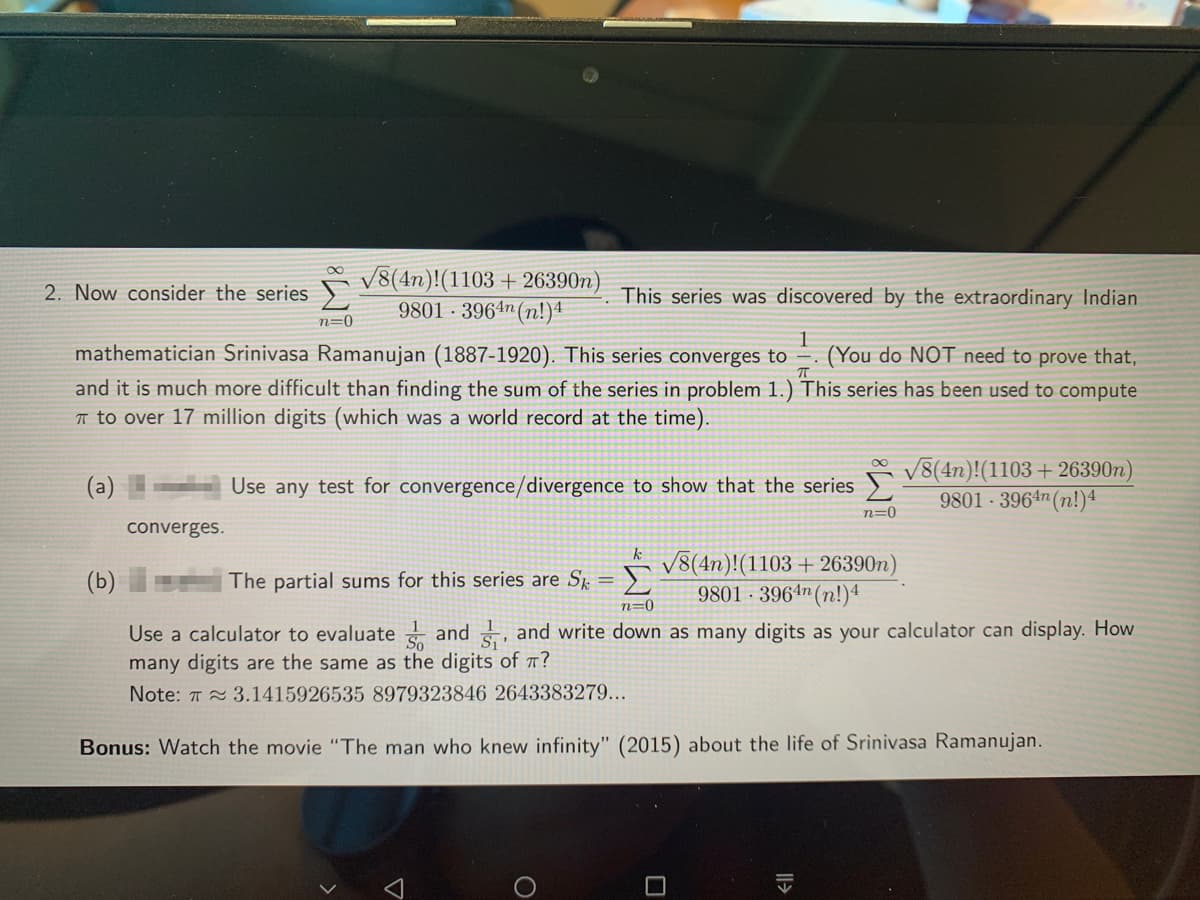2. Now consider the series r r8(4n)!(1103 + 26390n) 9801 - 3964n (n!)ª This series was discovered by the extraordinary Indian n=0 mathematician Srinivasa Ramanujan (1887-1920). This series converges to –. (You do NOT need to prove that, and it is much more difficult than finding the sum of the series in problem 1.) This series has been used to compute T to over 17 million digits (which was a world record at the time). V8(4n)!(1103 + 26390n) 9801 · 3964n (n!)4 (a) Use any test for convergence/divergence to show that the series ) n=0 converges. The partial sums for this series are S. = 5 v8(4n)!(1103 + 26390n) 9801 · 3964n (n!)4 (b) %3D n=0 Use a calculator to evaluate and , and write down as many digits as your calculator can display. How many digits are the same as the digits of 7? Note: 7 3.1415926535 8979323846 2643383279...
2. Now consider the series r r8(4n)!(1103 + 26390n) 9801 - 3964n (n!)ª This series was discovered by the extraordinary Indian n=0 mathematician Srinivasa Ramanujan (1887-1920). This series converges to –. (You do NOT need to prove that, and it is much more difficult than finding the sum of the series in problem 1.) This series has been used to compute T to over 17 million digits (which was a world record at the time). V8(4n)!(1103 + 26390n) 9801 · 3964n (n!)4 (a) Use any test for convergence/divergence to show that the series ) n=0 converges. The partial sums for this series are S. = 5 v8(4n)!(1103 + 26390n) 9801 · 3964n (n!)4 (b) %3D n=0 Use a calculator to evaluate and , and write down as many digits as your calculator can display. How many digits are the same as the digits of 7? Note: 7 3.1415926535 8979323846 2643383279...
Chapter9: Sequences, Probability And Counting Theory
Section9.4: Series And Their Notations
Problem 10TI: Determine whether the sum of the infinite series is defined. 24+(12)+6+(3)+
Related questions
Question
Written 8 Q2

Transcribed Image Text:V8(4n)!(1103 + 26390n)
9801 · 3964n (n!)1
2. Now consider the series
This series was discovered by the extraordinary Indian
n=0
mathematician Srinivasa Ramanujan (1887-1920). This series converges to
(You do NOT need to prove that,
and it is much more difficult than finding the sum of the series in problem 1.) This series has been used to compute
T to over 17 million digits (which was a world record at the time).
V8(4n)!(1103 + 26390n)
9801 · 3964n (n!)4
(a)
Use any test for convergence/divergence to show that the series )
n=0
converges.
k
V8(4n)!(1103 + 26390n)
(b)
The partial sums for this series are S,
Σ
9801 · 3964n(n!)4
n=0
Use a calculator to evaluate and , and write down as many digits as your calculator can display. How
many digits are the same as the digits of 7?
Note: 7 3.1415926535 8979323846 2643383279...
Bonus: Watch the movie "The man who knew infinity" (2015) about the life of Srinivasa Ramanujan.
Expert Solution
This question has been solved!
Explore an expertly crafted, step-by-step solution for a thorough understanding of key concepts.
Step by step
Solved in 4 steps with 4 images

Recommended textbooks for you


Algebra & Trigonometry with Analytic Geometry
Algebra
ISBN:
9781133382119
Author:
Swokowski
Publisher:
Cengage


Algebra & Trigonometry with Analytic Geometry
Algebra
ISBN:
9781133382119
Author:
Swokowski
Publisher:
Cengage